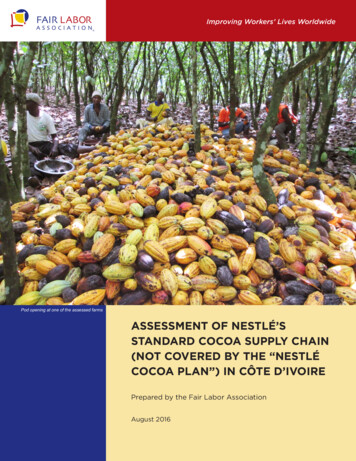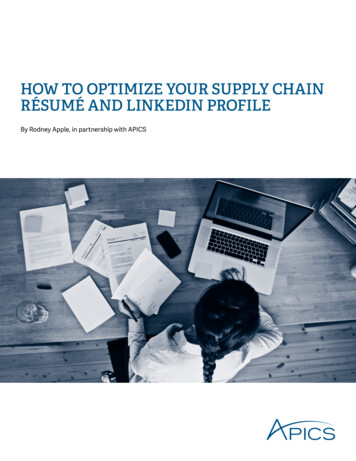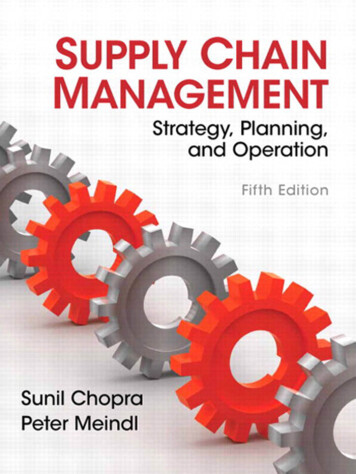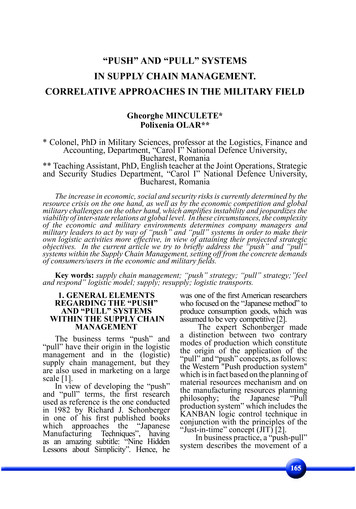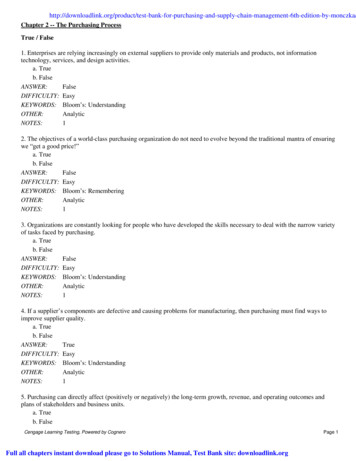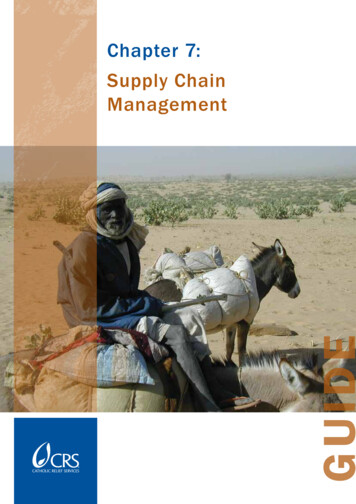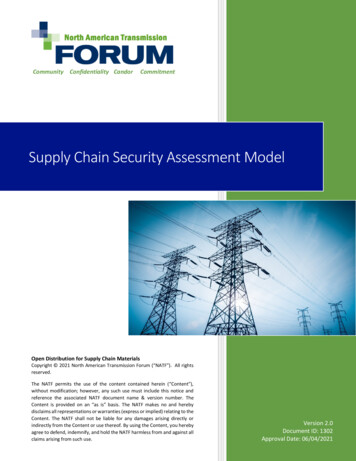
Transcription
Community Confidentiality CandorCommitmentSupply Chain Security Assessment ModelOpen Distribution for Supply Chain MaterialsCopyright 2021 North American Transmission Forum (“NATF”). All rightsreserved.The NATF permits the use of the content contained herein (“Content”),without modification; however, any such use must include this notice andreference the associated NATF document name & version number. TheContent is provided on an “as is” basis. The NATF makes no and herebydisclaims all representations or warranties (express or implied) relating to theContent. The NATF shall not be liable for any damages arising directly orindirectly from the Content or use thereof. By using the Content, you herebyagree to defend, indemnify, and hold the NATF harmless from and against allclaims arising from such use.Version 2.0Document ID: 1302Approval Date: 06/04/2021
Open Distribution for SupplyChain MaterialsVersioning and AcknowledgmentsContributing OrganizationsAmerican Public Power Association (APPA)Con Edison Working Group (ConEd)Edison Electric Institute (EEI)Ernst & Young, LLP (E&Y)GE PowerHitachi-ABB Power GridsISO/RTO Council (IRC)KPMGLarge Public Power Council (LPPC)National Rural Electric Cooperative Association (NRECA)North American Energy Standards Board (NAESB)North American Generator Forum (NAGF)North American Transmission Forum (NATF)OSISchneider ElectricSchweitzer Engineering Laboratories, Inc.Siemens Industry, Inc.Transmission Access Policy Group (TAPS)ULWith appreciation for the NATF Steering Team Members AmerenAmerican Electric PowerDuke EnergyExelonNebraska Public Power DistrictPJMSouthern CompanySupply Chain Security Assessment Model1
Open Distribution for SupplyChain MaterialsVersion pdated document with revised copyright06/04/20212.0Updated document content, figures, and appendicesReview and Update Requirements Update: as necessaryReview: every 3 yearsSupply Chain Security Assessment Model2
Open Distribution for SupplyChain MaterialsContentsVersioning and Acknowledgments.1Contents .31.Purpose .42.The Model.43.The Five Steps of the Model .54.Conclusion . 11For More Information. 12Appendix 1: Certification to Existing Framework/Standard . 13Appendix 2: Independent Assessment from Qualified Third-Party . 14Appendix 3: Working with a Third-Party Solution Provider . 15Appendix 4: Detailed Illustration of Model Steps . 16Supply Chain Security Assessment Model3
Open Distribution for SupplyChain Materials1. PurposeThe purpose of the Supply Chain Security Assessment Model (Model) is to provide a streamlined, effective, andefficient industry-accepted approach for entities to evaluate supplier supply chain security practices. The Modelhas been endorsed by the NATF-led Industry Organizations Team1 and is supported by solution providers2 and, ifapplied widely, will reduce the burden on suppliers, provide entities with more and better information, andimprove supply chain security. The tools contained in the Model and supporting services offered by solutionproviders will provide critical information for entities to consider when conducting risk assessments for potentialsuppliers of products and services.The overall objectives of this work were to 1) streamline common approaches to evaluating a supplier’s securitypractices, 2) provide for flexibility within common approaches, 3) ensure the common approaches are scalableto include all suppliers and purchasing entities, and 4) while focusing on good supply chain security practices,address compliance requirements.2. The ModelThe Model addresses supply chain risk management through five lifecycle phases (shown in Figure 1), takingeach phase of the lifecycle into an action (shown in Figure 2).Criteria forSupplierEvaluationWhat criteria orsecurity frameworkto measure against?SupplierEvaluationRiskAssessmentHow is a supplier’sadherence tocriteria verifiedand reported?How does an entityassess the risk ofmaking a purchasefrom the supplier?PurchaseMethod andTermsHow should anentity make thepurchase?Monitor RiskHow should anentity monitor thesupplier/productrisk afterpurchase?Figure 1: The Supply Chain Security Risk Assessment LifecycleThe five-step Model provides a solid foundation for identifying, assessing, and mitigating supply chain risks,provides for inclusion of suppliers and solution providers depending upon each entity’s needs, and provides forflexibility of each entity’s implementation. Further, the Model and complementary products from otherparticipating organizations3 provide tools that support good supply chain security practices. When executedproperly and with a focus on security, the Model will assist entities with meeting the compliance requirements1The NATF-led “Industry Organizations Team” includes representatives from energy industry trade organizations and forums, NATFmember utility representatives, key electric sector suppliers, and third-party assessors. A list of participants on the Industry OrganizationsTeam is located on the NATF public website at: ns.2 A solution provider is an organization that collects and provides supplier information and may provide additional services to assistcompanies with supplier risk assessments. See Appendix 3 for process detail.3 Complimentary products from other organizations are posted on the NATF public website at ain-industry-coordination.Supply Chain Security Assessment Model4
Open Distribution for SupplyChain Materialsof the NERC supply chain reliability standards,4 which initially became effective on October 1, 2020 and arerevised from time to time.5 The five steps of the Model are depicted below in Figure 2, and each step isexamined in more detail in the next section.6Figure 2: The Supply Chain Security Assessment Model3. The Five Steps of the ModelThe five steps of the Model provide a strong foundation to mitigate supply chain risks by encapsulating thenecessary actions and components of supply chain risk, without regard to whether the purchase is for IT, OT,software, firmware, hardware, equipment, components, or services. The actions contained within each step areoutlined in the following sections.1. Collect InformationThe Model provides the following tools for collecting information:1. The NATF Supply Chain Security Criteria (NATF Criteria), which can be used to collect informationfrom a supplier or can be used as a basis for measuring a supplier’s security posture/practices (i.e., a“best practices” list), and2. the Energy Sector Supply Chain Risk Questionnaire (NATF Questionnaire) to obtain more granularinformation on a supplier’s supply chain risk performance.Either tool can be used to collect information regarding the supplier’s risk management at thesupplier’s corporate level, for a specific product or service, and/or at the development system level.4In response to FERC Order No. 829, NERC Reliability Standards Project 2016-03 Cyber Security Supply Chain Risk Managementdeveloped new Reliability Standard CIP-013-1 and modified Reliability Standards CIP-005-6 and CIP-010-3, which collectively havebecome known as the “supply chain standards.”5 Information on the most current version of the supply chain standards can be located on the NERC website:https://www.nerc.com/Pages/default.aspx.6 A detailed illustration featuring the inputs to each step of the Model is provided in Appendix 4, Figure 6.Supply Chain Security Assessment Model5
Open Distribution for SupplyChain MaterialsThe NATF Criteria and the NATF Questionnaire are tools for collecting information from suppliers. The NATFCriteria are “best practices” by which to measure a supplier’s security posture. The Questionnaire providesquestions to assist entities in obtaining necessary information to use in the evaluations. These are not pass/faillists; they are designed to identify risks and provide an opportunity for mitigation.Entities should provide the entire NATF Criteria and/or the entire NATF Questionnaire to a supplier. Entitiesmay request that suppliers provide responses to all or some of the questions or criteria, and items not requiredto be completed by the supplier should be clearly identified by the entity. However, the supplier should have theoption to provide answers to all questions or criteria even if not required by the entity. Requesting responses intheir entirety assists suppliers in recognizing the tools, having responses prepared, and thus being able toprovide responses in a timely manner. Since they will be working with many entities across the industry and inmost cases will be providing all the responses, providing all of responses may simplify their ability to respond,meeting the entities’ needs and encouraging adoption across the industry. The entity can determine whichresponses they use in their risk assessments based on the supplier and the risk of the product or service beingprocured. When entities have additional questions, or need a question modified, those may be provided to thesupplier as an addendum to the NATF Questionnaire or Criteria.The entity’s risk assessment process determines the risk that could derive from a procurement, with input fromsources such as the NATF Criteria, NATF Questionnaire, certifications to existing frameworks/standards,independent assessments/audits from qualified third-parties, open-source information, shared entityassessments, other data sources, or a combination of these sources. Supplier answers to specific criteria orquestions may or may not prevent the entity from procuring a product from the supplier. The information fromthese various sources, as available, should be viewed as input to the risk assessment process documented byeach entity, and is not intended as a checklist of items to require mitigation. The entity’s risk assessment processshould identify risk and provide an opportunity for any mitigation the entity deems appropriate.Entities should obtain information from, or about, suppliers AND verify that the information isaccurate.The information received from or about a supplier can be verified in several ways:The supplier could provide a security framework report from a qualified independent third-partyThis would include either a certification to, or assessment of, a supplier’s performance to a securityframework from a qualified auditor or assessor. An entity should verify that the certification orassessment report addresses all of questions or criteria needed to analyze risk for the purchase, whichcan be done by reviewing the report’s Statement of Applicability. Mapping is provided to selectedsecurity frameworks in the NATF Criteria. Examples include: 7Certification - The supplier could provide a certification to an existing security framework (e.g.,IEC 62443, ISO 27001)7See Appendix 1 for process detailSupply Chain Security Assessment Model6
Open Distribution for SupplyChain Materials Independent assessment or audit - The supplier could provide its report from an independentassessment (e.g., SOC2) or audit8 by a qualified auditor or assessorEntity could procure a report from an independent third-partyThis would include either a report or audit conducted by a third-party professional organization orentity. The receiving entity should verify that the information collected addresses all the questions orcriteria needed to analyze risk for the purchase and should understand how the accuracy of theinformation was verified by the third-party. Solution Provider– Procure information and verification through a solution providerSharing prior purchaser audit – An audit or assessment another purchaser had conductedpreviously that could be obtained from the prior purchaser/entity, from the supplier, or from asolution providerThe supplier could provide verification of accuracy with the informationThis would consist of a self-attested response to the NATF Criteria or Questionnaire with supportingevidence that the purchasing entity could review.If the supplier cannot or will not provide information, a purchasing entity can seek information from othersources Investigate other external evaluations of the supplier (e.g., a Department of Defense maturityranking) Investigate open or private sources to verify supplier’s responses, including suppliers’ securitypolicy statements or trust-center webpages, financial reporting services, obtaining referencesfrom other entities that purchase from the supplier, etc. Use other verification methods, such as hardware, firmware and software security assessmentsor testingMapping to Third-Party Certifications and Assessments/AuditsThe NATF Criteria are provided on a spreadsheet and are mapped to several existing security frameworks. Thisis not an all-inclusive list. The criteria are intentionally provided in this format so that an entity could use it tomap the criteria to an additional security framework or certification. As entities add additional frameworks,their mapping could be included on the master NATF Criteria workbook to allow other entities to benefit fromtheir work. The critical observation would be to see which criteria are not addressed by the security framework,so an entity could use other methods, which may include a second security framework, to verify the suppliers’performance to those criteria.8See Appendix 2 for process detailSupply Chain Security Assessment Model7
Open Distribution for SupplyChain Materials2. Evaluate the Information/Address RisksWhen evaluating the information collected, an entity can determine:1. Whether the level of the supplier’s adherence to the NATF Criteria or the responses to theQuestionnaire identify any risks pertinent to the product or service being purchased2. Whether the level of assurance or verification of the accuracy of the supplier information issufficient for the product or service being purchased3. Whether any identified risks could be mitigated by the supplier or the entity, or if the risk could beaccepted.The purchasing entity can determine, based on the information and assurance provided, if any of the supplier’ssecurity practices raise a concern (i.e., are a risk) and whether that risk can be mitigated or accepted.9Considerations include:An evaluation of the supplier’s adherence to the NATF Criteria and/or response to the QuestionnaireDoes the supplier fully conduct all of the pertinent actions contained in the criteria and/or questionnaireor are there some pertinent actions that the supplier conducts partially? For any pertinent actions thatare not fully conducted, the entity can determine whether the non-action constitutes a risk.An evaluation of the level of assurance the supplier has provided for its responsesWas the supplier able to provide the purchasing entity with assurance that it performs as reported?Depending upon the potential impact the specific product or service could have on the Bulk-PowerSystem, the purchasing entity may require more assurance.An evaluation of the significance of any identified risks and how they could be addressedThe purchasing entity can ascertain whether it or the supplier could take actions or implement controlsto mitigate any identified risks or if the risks can be accepted.Mitigation of RisksIdentified risks are evaluated for potential mitigations that would result in a lower residual risk or an eliminationof the risk. Mitigations could be implemented by the supplier or by the entity. In some cases, the risk may besuch that it can be accepted. Through entities and suppliers working together on solutions for identified risk, it isanticipated that repeated identification of the same risks and implementation of mitigating activities will bringan overall increase in security, as depicted by the figure below:9TheNERC Supply Chain Working Group (SCWG) has developed a series of supply chain security guidelines that provide guidance forevaluating supplier information and in determining whether or how to mitigate risks. These are concise three-page documents thatprovide a high-level summary of issues to be aware of and potential methods of addressing them. The guidelines are available on theNERC website: https://www.nerc.com/comm/CIPC/Pages/SCWG.aspx and can be linked to from the NATF supply-chain-industry-coordination.Supply Chain Security Assessment Model8
Open Distribution for SupplyChain MaterialsFigure 3: The Vision for AlignmentDocument the DeterminationsMaintaining the supplier’s responses and documenting the evaluations will help the purchasing entity tomonitor risks after the purchase as well as demonstrate compliance.3. Conduct the Risk Assessment1. The entity should have a methodology to perform supplier risk assessments.102. The entity should document the results of risk assessments.The entity can then conduct a risk assessment to determine which suppliers could provide the desired productor service with the least amount of residual risk. There are a variety of methods that could be used to conduct arisk assessment.11 Some entities use the suppliers’ responses to the criteria in a staged approach, or gates,determining which criteria are the most critical for the product or service and assessing supplier risk in phases.Other entities use a rating and ranking methodology, and some use a combination of both.10The American Public Power Association, an Industry Organizations participating member, has developed a guide for conducting riskassessments: Cyber Supply Chain Risk Management, available on the APPA website: hain-risk-management and is linked on the NATF public website: hain-industrycoordination/all-resources.11 Id.Supply Chain Security Assessment Model9
Open Distribution for SupplyChain Materials4. Make Purchase Decision1. Develop a cross functional process to include the information from the supplier risk assessmentinto the entity’s purchase procedure.2. Consider other entity-identified factors and the entity’s risk appetite in supplier selection.3. When making a purchase decision and entering into a purchase agreement or contract an entityshould consider whether implemented or agreed upon mitigations can be supported by contractterms and conditions.The results from the supply chain risk assessment are one input into the entity’s procurement process andincludes consideration of any mitigations that would need to be implemented and monitore
An evaluation of the supplier’s adherence to the NATF Criteria and/or response to the Questionnaire Does the supplier fully conduct all of the pertinent actions contained in the criteria and/or questionnaire or are there some pertinent actions that the supplier

